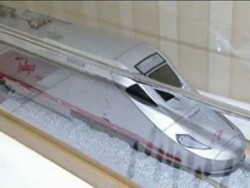By: Daniel Nardini

There is now serious talk about building a track network for high speed trains. The network would run from Chicago’s O’Hare Airport to Indianapolis and going west to St. Louis. Illinois towns and cities along this high speed corridor would see travel times cut by half, and this could lead to a dramatic increase in the number of passengers using the high speed network. According to Amtrak, the high speed trains could carry as many as 8 to 15 million passengers a year to and from St. Louis and Chicago (currently, Amtrak carries 597,519 passengers on that route a year), create 10,000 new jobs and invigorate the economies of many local towns on that route. The system could operate at a profit, and compete with airline service. If this can be done, Illinois will be the only U.S. midwest state with such an extensive network for high speed trains. The labor force it would take to build such a network could easily generate jobs in a whole list of sectors—providing food and lodging for such a workforce to businesses opening up for people who would provide services for such a workforce.
The real problem is the sticker price. This project could cost as much as U.S. $20 billion for constructing the Illinois network alone, and another U.S. $50 billion for extending it to St. Louis and Indianapolis. With Illinois already U.S. $203 billion in the hole, does the state want to take on this added expense? Already the midwest states of Wisconsin and Ohio have scrapped plans for creating a high speed network for high speed trains. The sticker price was too much for them. This leaves Illinois, Indiana and Missouri who share a common border. But trying to create a high speed train network for not only local travel in each others’ towns and cities but also for integration into a national high speed train network is a daunting task. Despite the price tag, and the uncertainty, Illinois Governor Pat Quinn and the Illinois Department of Transportation (IDOT) believe that creating such a high speed network is worth it.
I concur with this assessment. According to the IDOT, after a feasibility study, the costs now will be outweighed by the benefits not only to the state but to the nation as a whole. High speed train travel is now a reality in so many countries in Europe and in Asia. Speaking from experience, I have traveled on Japan’s shinkansen (bullet train) and South Korea’s KOEX high speed trains. It looks and feels like an airplane on the ground, and you hear hardly any sound at all. The seats are comfortable, and there are stewardesses selling food and drink on trays from one train car to another. The doors going in and out of the train to one’s final destination automatically open and close, and the train stations are just unbelievably ultra-modern. Yes, these vast high speed train networks were not easy to build, and must have cost a fortune. However, these high speed trains have not only made transportation more easy, and greatly cut down on the amount of time it takes to get from place to place, but it has increased the number of passengers going from one end of Japan and South Korea to the other fifty fold. So I ask myself, “why can’t we have this in Illinois?”


 New Illinois laws in Effect on July 1, 2025 July 3, 2025
New Illinois laws in Effect on July 1, 2025 July 3, 2025 ComEd, HIRE360 Celebrate New Graduates July 3, 2025
ComEd, HIRE360 Celebrate New Graduates July 3, 2025 ComEd Kicks Off Elk Grove Substation Expansion July 3, 2025
ComEd Kicks Off Elk Grove Substation Expansion July 3, 2025







The High Speed Pipe Dream?
By: Daniel Nardini